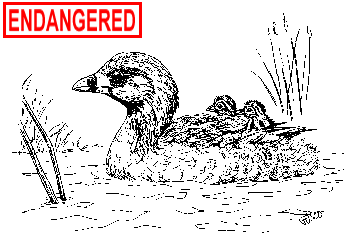Pied-billed Grebe
Podilymbus podiceps
Habitat: Streams, ponds, lakes and freshwater marshes. Winters in estuarine and marine habitats.
Weight: 10-18 ounces.
Length: 12-15 inches.
Wingspan: 23 inches.
Life Expectancy: 10-12 years.
Food: A variety of small fishes like sticklebacks and silversides; also damselfly and dragonfly nymphs, backswimmers, diving beetles and many other aquatic insects, snails, spiders, frogs, tadpoles, seeds and the soft parts of aquatic plants. Hatchlings are initially fed insects and then given small fishes as they grow.
Status: State endangered.
Identification: Adult pied-billed grebes are small, stocky and very brown. The belly is pale, and during the breeding season, there is black on the pied-billed’s chin and throat. During the summer, the short, blunt bill is encircled by a broad, black band. The pied-billed has lobed toes, which are characteristic of all grebes. However, unlike other grebes, the pied-billed shows almost no white on its wings during flight. Both sexes are similar in appearance.
Pied-billed grebes rarely call except during the breeding and nesting season. The call is loud and cuckoo-like: "cuck, cuck, cuck, cow-cow-cow, cow-ah, cow-ah."
Range: The pied-billed grebe ranges from British Columbia east to Nova Scotia and south throughout the United States wherever habitat is suitable. The species winters south of the winter ice line on freshwater or saltwater (infrequently along coastal Connecticut and Massachusetts).
Reproduction: The breeding season begins in mid-May. The nest is built by both sexes in 3 to 7 days. It consists of both green and decaying vegetation and has a distinct hollow. The nest may vary in its location. A floating nest is usually in the vegetation bordering open water. The nest may also be resting on the bottom in shallow water or it may be placed between the stems of growing plants. The 4 to 7 smooth, elliptical eggs are almost white when first laid but become nest-stained as they are incubated. The eggs, which are usually laid at daily intervals, are incubated initially by the female. The male assists the female in incubating the eggs until they begin to hatch, about 23 days after they are laid, at which time the female resumes solitary incubation.
The downy, precocial nestlings have a variable rufous, black and white striping pattern. Patches of bare yellow skin are visible on the lores (area between the bill and the eyes) and crown. After hatching, the young follow the adults, often riding on their backs or clinging to their tails. The adults will sometimes feed the chicks while they ride on their backs and will even dive below the water’s surface with the chicks aboard. It is fairly common for the pied-billed grebe to have 2 sets of chicks a year.
Reason for Decline: Pied-billed grebes nest in low numbers throughout their entire range. This, coupled with wetland degradation and loss, has resulted in a very small population. The species is declining throughout New England. In New Hampshire, they are classified as endangered, while in Massachusetts they are threatened. Vermont lists the pied-billed grebe as a species of special concern and Rhode Island considers it to be extirpated (locally extinct).
History in Connecticut: The pied-billed grebe was never a common, abundant nester in Connecticut. Reports of nesting began to decline throughout New England in the 1850s. Scattered nesting was recorded in southern Connecticut throughout the early 1900s. Since the late 1940s, pied-billed grebes have been reported in Connecticut most frequently during the midwinter and early spring. Few recent breeding locations have been confirmed in the state.
Interesting Facts: Pied-billed grebes are generally solitary. They "hide" from intruders by sinking down into the water until only their head is visible. Grebes do not dive as deeply as loons, usually about 20 feet or less. Dives last for about 30 seconds. Alarmed grebes dive so swiftly underwater that they have been called hell-diver and water witch. The birds may swim underwater when frightened until they reach plants in a shallow area, where they will remain submerged, except for their eyes and bill, until the perceived danger has passed.
Male pied-billed grebes often perform a territorial display with other males at the border of their territories. The males, with their heads held high and their bills up, turn away from each other and call. They then swing back to face each other.
Grebes have soft, thick, lustrous feathers. Their breast feathers were once used to decorate women’s hats.
Protective Legislation: Federal - Migratory Bird Treaty Act of 1918. State - Connecticut General Statutes Sec. 26-311.
What You Can Do: Support strong wetland protection legislation. Projects aimed at improving or restoring wetland areas for waterfowl will benefit the pied-billed grebe.
Since the nesting activities of the pied-billed grebe are often difficult to survey and monitor, any confirmed nests should be reported to the Wildlife Division at deep.wildlife@ct.gov or 860-424-3011 to help increase our knowledge of the activities of these birds in Connecticut.

The production of this Endangered and Threatened Species Fact Sheet
Series is made possible by donations to the Endangered Species/Wildlife Income Tax
Checkoff Fund.
(rev. 12/99)

